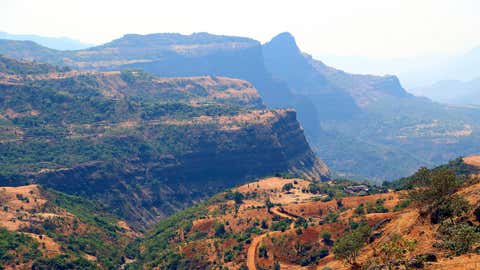
Deccan Traps
(Aditya Waikul/BCCL/TOI)
If you had to place a bet on who was responsible for the extinction of dinosaurs during the last mass extinction around 66 million years ago, who would you pick: volcanoes or large asteroids? Well, a multi-institutional research team led by scientists from the City College of New York (CUNY) would advise you to choose the latter. New insights of their research disfavour the past theory that CO2 emissions from volcanic eruptions from the Deccan Traps in India were a major driving force of the most recent mass extinction.
“This work brings us closer to understanding the role of magmas in fundamentally shaping our planet’s climate, and specifically helps us test the contributions of volcanism and the asteroid impact in the end-Cretaceous mass extinction” explains Benjamin Black, the study’s principal investigator and a professor at The Graduate Center at CUNY.
Scientists analyzed the amount and timing of CO2 released—one of the main gases released by the Deccan Traps—to determine the role of volcanic eruptions in climate shifts around the end-Cretaceous mass extinction. This research closely examines the accuracy of past theories that identified massive volcanic eruptions as the probable driving force of environmental changes that led to at least three mass extinction events.
What are the Deccan Traps?
According to previous research, Deccan Traps are identified as one of the largest volcanic provinces in the world which consists of flat-lying basalt lava flows and covers an area of nearly 500,000 square kilometres in West-Central India.
About 65 million years ago, the basalt in these areas erupted and released gases that changed the global climatic conditions. Some early models studying this historical phenomenon suggested that lava flooded across large areas at extremely rapid rates, while recent models claim that this process occurred gradually. These recent studies also indicated that the eruptions occurred in three main phases that created different sediments and climatic conditions.
This volcanism produced the longest lava mega-flows on Earth, spanning from the main Deccan province in India to Rajahmundry, Andhra Pradesh to the Gulf of Bengal.
Global warming after the eruption of Deccan Traps
In the past, scientists have linked the eruption of the Deccan Traps to a global warming event that occurred several hundred thousand years ago before the Cretaceous extinction. However, doubts have been raised regarding whether the amount of CO2 released in the atmosphere due to the eruption was enough to cause the global warming event. A major challenge in solving this debate has been the lack of data regarding the amount of CO2 released from Deccan magmas during this time period.
Advertisement
“Our team analyzed Deccan Traps CO2 budgets that coincided with the warming event, and we found that carbon outgassing from lava volumes alone couldn’t have caused that level of global warming,” said Andres Hernandez Nava, a PhD student in The Graduate Center, CUNY’s Earth and Environmental Science program.
However, this new study found that by factoring in the release of CO2 from the magmas that did not erupt due to being frozen beneath the surface, the link between the Deccan Traps and the global warming event can be explained.
Magmas interaction with surface climate
Using lasers and beams of ions to measure the amount of CO2 present in the tiny droplets of frozen magma inside the Deccan Traps’ crystals, the researchers were able to get an accurate picture of the amount of CO2 present in the end-Cretaceous period. Using this data, they modelled the latest Cretaceous climate to test the impact of the release of carbon from the eruption of Deccan Traps on surface temperature.
These results help in filling significant knowledge gaps about the interaction between magmas and surface climate during the end of the Cretaceous period. The data from the study showcased that CO2 outgassing from Deccan Traps’ magmas can explain the warming of Earth’s global temperatures by roughly 3°C during the early phases of Deccan volcanism.
However, the researchers also noted that there was not nearly enough warming in the period close to the mass extinction event. This supports the idea that later Deccan magmas were not releasing enough CO2 to cause the extinction and subsequently disfavors the past theory that carbon emissions during the volcanic eruption were a major driving force behind the mass extinction of dinosaurs.
This research was funded by the National Science Foundation. Their results were published on Monday, March 29, in the journal Proceedings of the National Academy of Sciences and can be accessed here.
**
For weather, air pollution, science, and COVID-19 updates on the go, download The Weather Channel App (on Android and iOS store). It’s free!
ఇవి కూడా ఓ లుక్కేయండి ..
- Take stringent action against police for Majji’s suicide: TDP
- BJP to step up offensive against Jagan govt?
- East Godavari parents worried over TPR as schools set to open on August 16
- Passenger amenities inspected at Vijayawada, Rajamahendravaram railway stations
- This Independence Day, O2O optical chain MyValueVision.com is launching a 24×7 eye care on …
- SC Rly CCM inspects Vijayawada railway station
